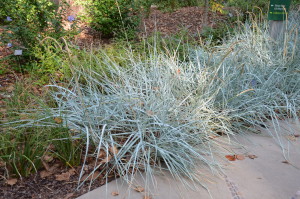Blue Lyme Grass (Leymus arenarus ‘Blue Dune’) is a vigorous spreading cool season grass (USDA Hardiness zones 3-9). It is native to the coasts of northern and western Europe. A closely related species, L. mollis, is native to the northern coasts of North America.
Blue lyme grass is a stand out because of its beautiful steel-blue foliage. Atlanta Botanical Gardens has sited it in woodland setting under filtered sunlight while the Dallas Arboretum grows it under full hot Texas sun. It will rapidly fill in hot arid places such as near hot concrete walkways and driveways.
‘Blue Dune’ is a standout selection with steel blue foliage. Clumps average 2 – 3 feet high and spread. In mid-summer arching powder blue flower spikes (inflorescences) emerge. Some gardeners may opt to remove the flowers to accent foliage only. It is also very tolerant of salt spray and drought.
Lyme grass is a spreading cool season perennial grass in full sun or partial shade. Foliage is evergreen into the lower 20s. Plants grow equally well either full all-day sun or under several hours of moderate shade. Practice low soil fertility as this grass can become too aggressive. It tolerates a wide range of soils from wet to dry. It tends to be less aggressive in dry, clay soils and foliage becomes more silvery blue in color.
Landscape Use: Lyme Grass can be used along woodland borders, in mass plantings, in containers or planters, as a border or edger, around decks, swimming pools, and other outdoor living areas, in landscape beds or islands, to stabilize steep slopes and sand dunes. It is resistant to deer, rabbits, drought, insects, diseases, mildew, heat and butterflies are attracted to its flowers.
Mow off old foliage in late fall or early spring to refresh the planting. Clumps are easily divided at this time.


 Posted in
Posted in 
